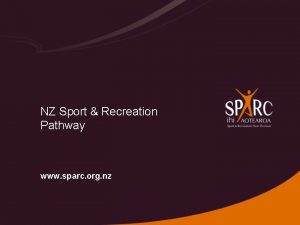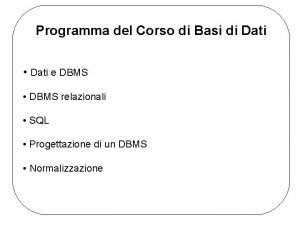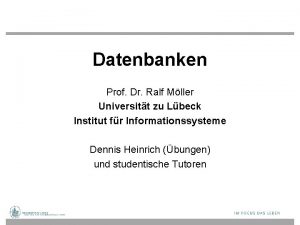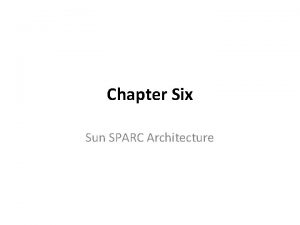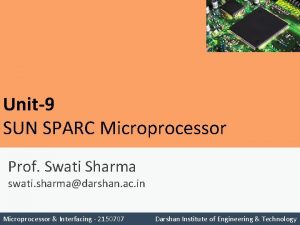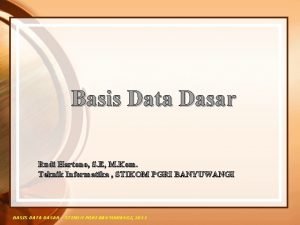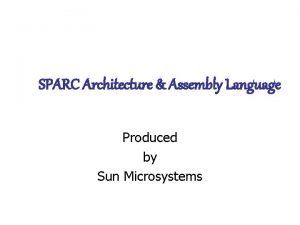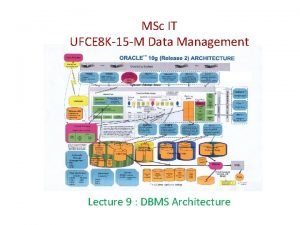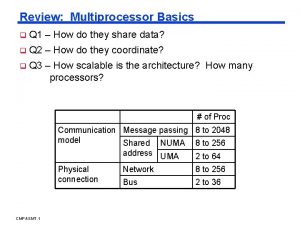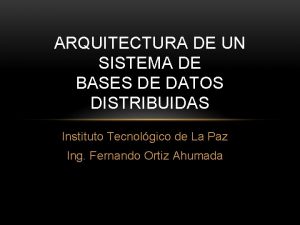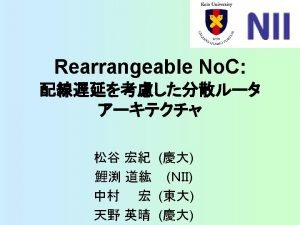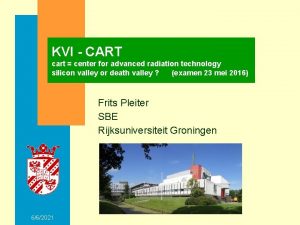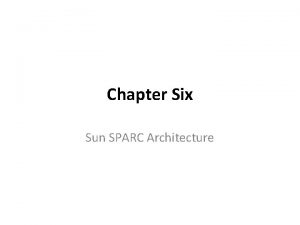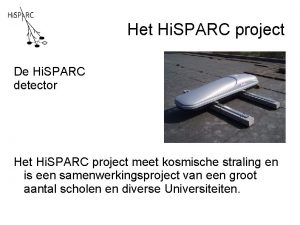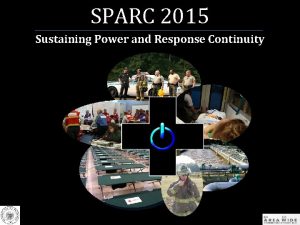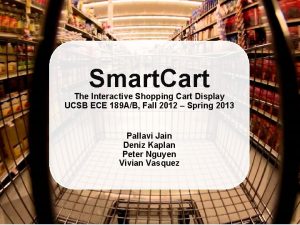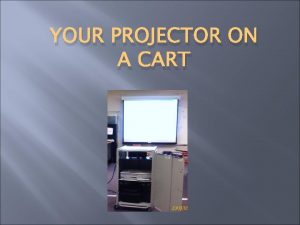SelfPowered Automated Refuse Cart SPARC Group 12 Alexis






































- Slides: 38

Self-Powered Automated Refuse Cart (SPARC) Group 12 Alexis Drayton Chris Vento Wyatt Schmitz Sean Mc. Garvey Sponsored By:

Project Motivation ● Automation of simple domestic tasks ● Accessibility for those who cannot physically move trash ● Quality of life improvement for people with abnormal working schedules

Goals and Objectives ● Autonomously carry a Garbage Bin down a driveway to a curb, and return back to a charging station, based on a schedule. ● Detects and Avoid obstacles. ● Schedule setting, Manual control available through a mobile application ● Autonomously connects to recharging station


Specifications and Requirements ● ● ● Fully autonomous vehicle Capable of carrying up to 50 lbs Fully rechargeable User Interface with a Mobile Application User manual control User scheduled service Automatically notify the user of important events Collision avoidance capabilities Sturdy and robust enough to handle trash collection Waterproof Battery capacity to traverse the user’s driveway in both directions.

Operating Procedure 1) 2) 3) 4) 5) 6) 7) Wake up from standby based on internal clock, and scheduled time. Locate self-GPS position and compare to destination GPS location. Move to destination, avoiding obstacles. Return to standby. Wake up from standby for return trip based on schedule. Return to Charge location, remembered from step 2. Return to standby.

Charging Platform (Home Base) ● Plugs into standard 120 V AC Wall outlet. ● AC/DC Laptop Charger with Barrel Jack ○ 18 V, 3 A Output ● Three 2 A 16 V Regulators for output to Main Unit ● One 2 A 5 V Regulator to power RF Receivers. ● Two RF Receivers (315 MHz and 433 MHz), into SR NOR Latch to enable or disable output from 16 V Regulators


Power OUT Power IN

Internal Power - 14. 8 V Battery Bank - Thirty-Two 18650 Batteries, 4 -series, 8 parallel, 20, 000 m. Ah 8 Overcharge Protection chips, 2 per series cell - Eleven 2 A 12 V Regulators for Motors - One 2 A 5 V Regulator for USB/Pixy. Cam and IR Sensor - One 2 A 3. 3 V Regulator for MCU, GPS, Bluetooth, and RF Transmitters.


Motors - 2 DC Motors, 12 V, 17200 RPM, 4. 47 oz-in rate torque - 6 A draw at rated torque Through 81: 1 Gearbox - 362. 07 oz-in torque + 212 RPM after gearbox conversion. Circuit designed to carry Max of 10 A per motor - At 10 A, 600 oz-in torque. Should be able to pull 1200 oz. without damage to circuit. 50 Pounds of trash (estimated capacity of trash can) = 800 oz Motors controlled by H-Bridge, controlled by MCU


Chassis - Will be built from Aluminum, edges sealed to prevent rain damage. - 6 wheels, middle wheels powered, front and back free rolling to allow easy turning. - Will have location to attach the trash can via straps.

Concept Art

Software Development ● Three Parts: ○ Pathing & Collision Avoidance ○ Firmware ○ Mobile Application

Pathfinding

Simultaneous Location and Mapping (SLAM) ● Refers to Creating and/or Updating a graph of an undefined system while tracking an agent’s position in that space ● Simply keeping track of the movement information of the agent is not enough; these measurements have margins of error and the amount of error compounds with operation space ● This can be overcome by periodically referencing Landmarks to reorient the agent in the problem space.

SLAM - Challenges for SPARC Design ● Price point must be competitive; Taking out the trash is not likely to be worth several hundreds of dollars to the average user. ● Fully mapping the operation area is not possible; unknown property boundaries must be respected ● Artificial Landmarking has a very high utility cost in accessibility, which conflicted with our design goals of designing a device that has a high accessibility factor.

Alternate Design Concept ● An early concept explored for the SPARC utilized passive RFID stakes to create a RTLS (real-time location system) with the SPARC crawler. ● GPS design was preferable due to the low accessibility of this alternate design despite its low cost

GPS Module ● The Pam 7 Q was selected for its relatively low cost and high accuracy. ● The SPARC’s slow movement makes its slow baud rate a negligible drawback. Part Name Manufacturer Price Baud Rate Accuracy Pam-7 Q U-Blox America Inc. $41 9600 bps > 2. 0 m LS 20031 LOCOSYSA Technology Inc. $60 57600 bps ~ 2. 5 m Venus 638 FLPx-L Sky. Traq Technology Inc. $50 115200 bps ~ 2. 5 m

Algorithm Flowchart Diagram

Rangefinding ● Opted for Infrared over Ultrasonic; noise damping of shrubberies was of concern. ● Li. DAR too far out of price target Part Name Manufacturer Price Range Type GP 2 Y 0 A 710 K 0 F SHARP $16 100 -550 cm Infrared DE Li. Dar TF 02 Benewake $99 0. 4 -22 m LIDAR SEN 136 B 5 B Seeed Studio $15 3 -400 cm Ultrasonic

Pixy. Cam ● Integrated Computer Vision device we use to identify the start and endpoints. ● Uses color filtering to identify pre-programmed objects. ● Colored markers are applied on charge station and on single stake driven at the endpoint for high precision

Value Iteration ● The SPARC learns about its problem space by recording information about each path it takes, and the locations of detected obstacles. ● The user initializes a preferred path during setup utilizing the remote control feature of the mobile app. 10 ● 1 10 2 10 1 1 10 0 0 3 10 0 4 10 0 3 10 0 10 ★

Firmware

Microcontroller Comparison ● A microcontroller needed to be chosen to run the code and interface with the modules Microcontroller Manufacturer Total # of Pins FLASH(KB) SRAM (KB) Cost 64 256 32 $3. 39 Texas Instruments 48 256 64 $6. 86 ATSAMD 21 J 18 A-AUT Atmel MSP 432 P 401 RIRGC ● Decided on the ATSAMD 21 J 18 A-AUT (Arduino Zero chip) for its large number of pins, low cost, and compatibility with other components like the Pixy. Cam

Firmware ● ● Interfacing with the Bluetooth module and app Pulling inputs from camera and other sensors Sending output to motor control units (MCU) Initiating standby modes and handling user-scheduled activation

Mobile Application

Mobile Application ● The main connection between the user and the SPARC ● Android Application ● Bluetooth Connection ● Service Scheduling and Monitoring ● Manual Movement Control

Bluetooth v Wifi ● A wireless connection technology needed to be chosen to connect the application to the SPARC Protocol Speed Range Power Consumption Stability Cost Bluetooth 25 Mbps 100 m Low Only 2. 4 GHz bands HC 06: $$4. 02 Wifi 250 Mbps 200 m to 400 m High Both 2. 4 GHz and 5 Hz bands ESP 8266: $6. 95 ● Bluetooth chosen for this application that values low power consumption, price and ease of implementation

User Interface Design ● Start Up Screen ○ Loads user data ● Login Screen ○ User sign in

User Interface Design ● Sign Up Screen ○ User account creation ● Main Control Screen ○ ○ SPARC movement controls Device Scheduling controls User settings Device settings

Administrative Content

Budget Main Components Estimated Budget Chassis and Trash Can containment parts ~$200. 00 Wheels and other Mechanics ~$100. 00 Printed Circuit Boards ~$150. 00 External Hardware Modules ~$70. 00 Miscellaneous Hardware parts ~$100. 0 Camera ~$70. 00 Power Supply Components ~$200. 00 Microcontroller and other electronics ~$100. 00 Estimated Total: ~$1000

Work Distribution Hardware Alexis Drayton Sean Mc. Garvey P Wyatt Schmitz s Chris Vento s P: Primary s: Secondary Mobile Application Firmware P s Pathing P P

Work Progress

Questions?
 Why did rockwood refuse to conform to group pressure?
Why did rockwood refuse to conform to group pressure? Sparc nz
Sparc nz Oracle cloud sparc
Oracle cloud sparc Schema logico
Schema logico Konzeptionelles datenmodell beispiel
Konzeptionelles datenmodell beispiel Oracle sparc roadmap
Oracle sparc roadmap Sun sparc architecture
Sun sparc architecture Swati sun
Swati sun Arsitektur database
Arsitektur database Ansi/sparc
Ansi/sparc Sun sparc architecture
Sun sparc architecture Sparc quiz answers
Sparc quiz answers Factbase definition
Factbase definition Sparc
Sparc Arquitectura de un sistema de base de datos
Arquitectura de un sistema de base de datos Westinghouse nuclear
Westinghouse nuclear Ansi/sparc
Ansi/sparc Sparc
Sparc I'll make him an offer he can't refuse
I'll make him an offer he can't refuse Tonbridge and malling waste collection
Tonbridge and malling waste collection Wood recycling swansea
Wood recycling swansea Dustless refuse collector
Dustless refuse collector Cheat 3. hali
Cheat 3. hali Verb + object + to-infinitive
Verb + object + to-infinitive Crucible act 2 discussion questions
Crucible act 2 discussion questions Torfaen chief executive
Torfaen chief executive Solid waste management definition
Solid waste management definition West devon borough council refuse collection
West devon borough council refuse collection Why does she want the wretched refuse of teaming shores?
Why does she want the wretched refuse of teaming shores? Do not refuse
Do not refuse Refusal skills for peer pressure
Refusal skills for peer pressure Why does jem openly defy atticus and refuse to leave?
Why does jem openly defy atticus and refuse to leave? Example of negative peer pressure
Example of negative peer pressure 3r adalah
3r adalah Refuse to be discouraged
Refuse to be discouraged Emergency cart drugs
Emergency cart drugs A blue lab cart is traveling west
A blue lab cart is traveling west Golf cart rules
Golf cart rules Kvi cart
Kvi cart

